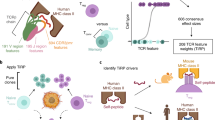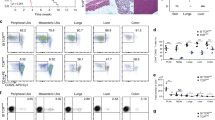Abstract
Major histocompatibility complex (MHC) class I and II molecules are highly polymorphic proteins that bind and present foreign peptides to the clonally distributed αβ receptors (TCR) of T lymphocytes. As a population, the immature T lymphocytes generated in the thymus express a very diverse set of TCR specificities. A process of positive selection filters this broad repertoire to optimize peripheral T cells for antigen recognition in the context of available MHC products. Only those precursor T cells whose TCRs generate an adequate but not excessive signalling response to self-peptides bound to the expressed MHC proteins undergo successful maturation1. Here we show that post-thymic self-recognition facilitates the antigen reactivity of mature T cells. Both experimental and physiological interruption of T-cell contact with self-peptide MHC ligands leads to a rapid decline in signalling and response sensitivity to foreign stimuli. Because the adaptive immune system must be recruited early in an infectious process when antigen is limiting2, these findings suggest that positive selection ensures predictable T-cell recognition of available self-ligands, which in turn promotes efficient responses to pathogens.
This is a preview of subscription content, access via your institution
Access options
Subscribe to this journal
Receive 51 print issues and online access
$199.00 per year
only $3.90 per issue
Buy this article
- Purchase on Springer Link
- Instant access to full article PDF
Prices may be subject to local taxes which are calculated during checkout




Similar content being viewed by others
References
Robey, E. & Fowlkes, B. J. Selective events in T cell development. Annu. Rev. Immunol. 12, 675–705 (1994)
Cohn, M. & Langman, R. E. The protecton: the unit of humoral immunity selected by evolution. Immunol. Rev. 115, 11–147 (1990)
Witherden, D. et al. Tetracycline-controllable selection of CD4(+ ) T cells: half-life and survival signals in the absence of major histocompatibility complex class II molecules. J. Exp. Med. 191, 355–364 (2000)
Dorfman, J. R., Stefanová, I., Yasutomo, K. & Germain, R. N. CD4 + T cell survival is not directly linked to self-MHC-induced TCR signaling. Nature Immunol. 1, 329–335 (2000)
Taniguchi, T. & Takaoka, A. A weak signal for strong responses: interferon-α/β revisited. Nature Rev. Mol. Cell Biol. 2, 378–386 (2001)
Kersh, B. E., Kersh, G. J. & Allen, P. M. Partially phosphorylated T cell receptor ζ molecules can inhibit T cell activation. J. Exp. Med. 190, 1627–1636 (1999)
Zell, T. et al. Single-cell analysis of signal transduction in CD4 T cells stimulated by antigen in vivo. Proc. Natl Acad. Sci. USA 98, 10805–10810 (2001)
Hemmer, B., Stefanová, I., Vergelli, M., Germain, R. N. & Martin, R. Relationships among TCR ligand potency, thresholds for effector function elicitation and the quality of early signaling events in human T cells. J. Immunol. 160, 5807–5814 (1998)
Iezzi, G., Karjalainen, K. & Lanzavecchia, A. The duration of antigenic stimulation determines the fate of naive and effector T cells. Immunity 8, 89–95 (1998)
Doyle, C. & Strominger, J. L. Interaction between CD4 and class II MHC molecules mediates cell adhesion. Nature 330, 256–259 (1987)
Crump, A. L., Grusby, M. J., Glimcher, L. H. & Cantor, H. Thymocyte development in major histocompatibility complex-deficient mice: evidence for stochastic commitment to the CD4 and CD8 lineages. Proc. Natl Acad. Sci. USA 90, 10739–10743 (1993)
Koller, B. H., Marrack, P., Kappler, J. W. & Smithies, O. Normal development of mice deficient in β2M, MHC class I proteins, and CD8 + T cells. Science 248, 1227–1230 (1990)
Gascoigne, N. R. Interaction of the T cell receptor with bacterial superantigens. Semin. Immunol. 5, 13–21 (1993)
Butcher, E. C., Williams, M., Youngman, K., Rott, L. & Briskin, M. Lymphocyte trafficking and regional immunity. Adv. Immunol. 72, 209–253 (1999)
Saitoe, M., Schwarz, T. L., Umbach, J. A., Gundersen, C. B. & Kidokoro, Y. Absence of junctional glutamate receptor clusters in Drosophila mutants lacking spontaneous transmitter release. Science 293, 514–517 (2001)
Dittel, B. N., Stefanová, I., Germain, R. N. & Janeway, C. A. Jr Cross-antagonism of a T cell clone expressing two distinct T cell receptors. Immunity 11, 289–298 (1999)
Kersh, E. N., Shaw, A. S. & Allen, P. M. Fidelity of T cell activation through multistep T cell receptor ζ phosphorylation. Science 281, 572–575 (1998)
Bray, D., Levin, M. D. & Morton-Firth, C. J. Receptor clustering as a cellular mechanism to control sensitivity. Nature 393, 85–88 (1998)
Germain, R. N. & Stefanová, I. The dynamics of T cell receptor signaling: complex orchestration and the key roles of tempo and cooperation. Annu. Rev. Immunol. 17, 467–522 (1999)
Gestwicki, J. E. & Kiessling, L. L. Inter-receptor communication through arrays of bacterial chemoreceptors. Nature 415, 81–84 (2002)
Smith, K. et al. Sensory adaptation in naive peripheral CD4 T cells. J. Exp. Med. 194, 1253–1261 (2001)
Kassiotis, G., Garcia, S., Simpson, E. & Stockinger, B. Impairment of immunological memory in the absence of MHC despite survival of memory T cells. Nature Immunol. 3, 244–250 (2002)
Micheletti, F. et al. Supra-agonist peptides enhance the reactivation of memory CTL responses. J. Immunol. 165, 4264–4271 (2000)
Wülfing, C. et al. Costimulation and endogenous MHC ligands contribute to T cell recognition. Nature Immunol. 3, 42–47 (2002)
Shinkai, Y. et al. Restoration of T cell development in RAG-2-deficient mice by functional TCR transgenes. Science 259, 822–825 (1993)
Kaye, J. et al. Selective development of CD4 + T cells in transgenic mice expressing a class II MHC-restricted antigen receptor. Nature 341, 746–749 (1989)
Seder, R. A., Paul, W. E., Davis, M. M. & Fazekas de St Groth, B. The presence of interleukin 4 during in vitro priming determines the lymphokine-producing potential of CD4 + T cells from T cell receptor transgenic mice. J. Exp. Med. 176, 1091–1098 (1992)
Janeway, C. A. Jr et al. Monoclonal antibodies specific for Ia glycoproteins raised by immunization with activated T cells: possible role of T cell bound Ia antigens as targets of immunoregulatory T cells. J. Immunol. 132, 662–667 (1984)
Ding, L., Linsley, P. S., Huang, L.-Y., Germain, R. N. & Shevach, E. M. IL-10 inhibits macrophage costimulatory activity by selectively inhibiting the up-regulation of B7 expression. J. Immunol. 151, 1224–1234 (1993)
Itoh, Y. & Germain, R. N. Single cell analysis reveals regulated hierarchical T cell antigen receptor signaling thresholds and intraclonal heterogeneity for individual cytokine responses of CD4 + T cells. J. Exp. Med. 186, 757–766 (1997)
Acknowledgements
We thank A. Fox for technical support, O. Schwartz for assistance with microscopy and image preparation, S. Stoll for assistance with mice, A. Iwasaki and B. Kelsall for reagents, and the members of the Germain laboratory for discussion.
Author information
Authors and Affiliations
Corresponding author
Ethics declarations
Competing interests
The authors declare that they have no competing financial interests.
Rights and permissions
About this article
Cite this article
Stefanová, I., Dorfman, J. & Germain, R. Self-recognition promotes the foreign antigen sensitivity of naive T lymphocytes. Nature 420, 429–434 (2002). https://doi.org/10.1038/nature01146
Received:
Accepted:
Issue Date:
DOI: https://doi.org/10.1038/nature01146
This article is cited by
-
CD3ζ ITAMs enable ligand discrimination and antagonism by inhibiting TCR signaling in response to low-affinity peptides
Nature Immunology (2023)
-
Learning from Persistent Viremia: Mechanisms and Implications for Clinical Care and HIV-1 Cure
Current HIV/AIDS Reports (2023)
-
Immune receptor inhibition through enforced phosphatase recruitment
Nature (2020)
-
Strength of tonic T cell receptor signaling instructs T follicular helper cell–fate decisions
Nature Immunology (2020)
-
Heavy metal protease takes a tiki torch to HIV assembly
Nature Immunology (2019)
Comments
By submitting a comment you agree to abide by our Terms and Community Guidelines. If you find something abusive or that does not comply with our terms or guidelines please flag it as inappropriate.



